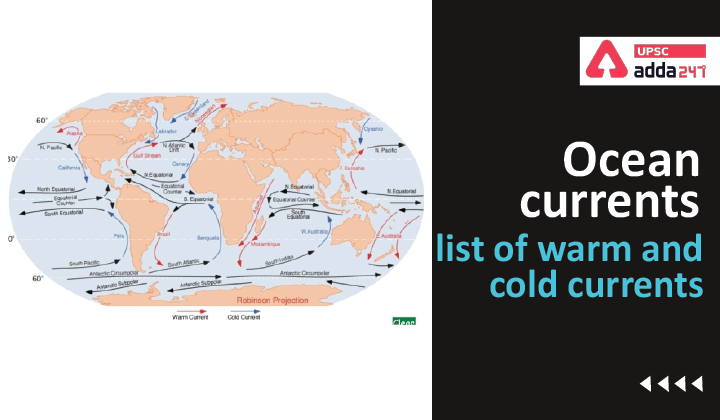Table of Contents
Ocean currents UPSC is an important topic for IAS exam. It can be asked both in UPSC Prelims and UPSC Mains as the topic involves both the concept and the memorizing part. It will be a 2-article articles. In this article, we will discuss about ocean currents and the list of cold currents.
What are ocean currents?
- Ocean currents are the continuous, predictable, directional movement of seawater driven by gravity, wind and water density.
- Ocean water moves in two directions: horizontally and vertically. Horizontal movements are referred to as currents, while vertical changes are called upwellings or downwellings (It will be discussed later).
- This abiotic system is responsible for the transfer of heat, variations in biodiversity, and Earth’s climate system.
Forces influencing ocean currents
- Ocean currents are primarily influenced by two types of forces.
Primary Forces
- These are forces that start the movement of water. Like:
- heating by solar energy;
- wind;
- gravity;
- Coriolis force.
Secondary forces
- These are forces that influence where the currents flow
- Temperature difference;
- Salinity difference.
Types of ocean currents
- Ocean currents can be categorised (i) on the basis of depth; (ii) on the basis of temperature.
On the basis of depth
- Ocean currents are of two types: Surface currents and Deep-water currents.
Surface currents
- The upper 400 meters of the ocean are generally called the surface currents.
- They make up about 10% of all the water in the ocean.
Deep water currents
- These waters make up the other 90% of the ocean
- They move around the ocean basins by density driven forces and gravity.
- These deep waters sink into the deep ocean basins at high latitudes where there is high density due to cold temperature.
On the basis of temperature
- Ocean currents are classified as cold currents and warm currents.
Cold currents
- Cold currents travel from high latitudes to low latitudes and thus bring cold water into warm water areas.
- These currents are usually found on the west coast of the continents in the low and middle latitudes (true in both hemispheres) and on the east coast in the higher latitudes in the Northern Hemisphere;
- They flow in clockwise direction in northern hemisphere and in anti-clockwise direction in southern hemisphere due to Coriolis force.

Below is the list of cold ocean currents in the world.
List of cold ocean currents
| Cold Ocean Current | Region | Important Points |
| Humboldt or Peruvian Current | South Pacific Ocean |
|
| Kurile or Oyashio Current | North Pacific Ocean |
|
| California Current | Pacific Ocean |
|
| Antarctic Circumpolar Current | Southern Ocean |
|
| Labrador Current | North Atlantic Ocean |
|
| Canary Current | North Atlantic Ocean |
|
| Eastern Greenland Current | Arctic Ocean & North Atlantic Ocean |
|
| Benguela Current | South Atlantic Ocean |
|
| Falkland Current | South Atlantic Ocean |
|
| Northeast Monsoon Current | North Indian Ocean |
|
| Somali Current | West Indian Ocean |
|
| Western Australian Current | Southern Ocean & South Indian Ocean |
|
| South Indian Ocean Current | South Indian Ocean |
|
We will discuss more about ocean currents and the concept of gyres, upwelling, downwelling, among other topics in our next article. We will also discuss about warm ocean currents and will provide you a list of warm ocean current in our next article.
Also Read:




 TSPSC Group 1 Question Paper 2024, Downl...
TSPSC Group 1 Question Paper 2024, Downl...
 TSPSC Group 1 Answer key 2024 Out, Downl...
TSPSC Group 1 Answer key 2024 Out, Downl...
 UPSC Prelims 2024 Question Paper, Downlo...
UPSC Prelims 2024 Question Paper, Downlo...





